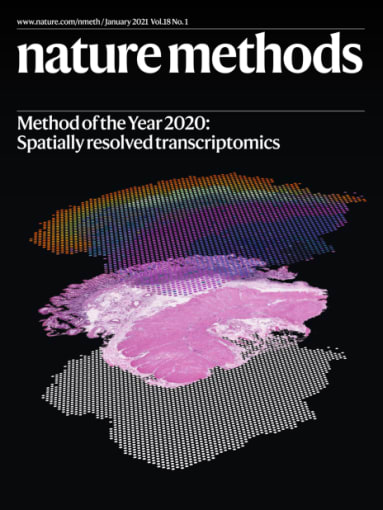Spatially resolved transcriptomics: a bright future ahead
The future of biology is spatial. Named Method of the Year 2020 by Nature Methods, spatially resolved transcriptomics has become the latest frontier for leading-edge research, allowing scientists to both measure the gene activity in a tissue sample and map where it occurs.

As researchers continue to push the boundaries of scientific study, our ability to explore complex biological systems has grown and changed to accommodate new discoveries and insights. For example, with single cell RNA-sequencing, we can measure cellular heterogeneity like never before, identifying specific changes within individual cells and exploring how they contribute to fundamental biological mechanisms. But, with all these new answers, we have new questions. Now that we can figure out what’s happening, we need to understand where it’s happening. Looking at a specific tissue section, we can start to ask: How does tissue architecture affect cellular function and phenotype? How are individual cell types and states within a tissue interacting, and does location contribute to these interactions?
These are just a few of the questions spatially resolved transcriptomics will help us answer, and that’s exciting. The possibilities for discovery are beginning to come into focus, especially considering the potential to more fully study structurally complex tissues (for example, brain and tumor). Still, we don’t know the extent of what researchers will uncover in the coming years and how those insights will inform our next steps. We just know that we can’t wait to find out.
We talked to 10x-experts Courtney Anderson and Zach Bent about their perspective on spatially resolved transcriptomics. Keep reading to find out why they think it qualifies as Method of the Year and how they see it shaping the future of biology.

How exciting is it to see spatially resolved transcriptomics named method of the year?
Courtney: It is incredibly exciting to see spatially resolved transcriptomics get this accolade. It is a method that has roots starting from the 1960's when Mary Lou Pardue and Joseph Gall first pioneered spatial gene expression through the in situ methodology to examine one gene at a time in a tissue section—now we are at the stage where we can explore the whole transcriptome in a single tissue section. It's just incredible to see the progress and how scientists are pushing the boundaries.
Zach: I'm thrilled to see the community so rapidly adopt this technology. The team has put in a lot of hard work over the last two years to get some high quality and compelling products to market. Our customers are generating very impactful papers that are changing the way we think about biology. The best part of all of this is that we're really just getting started. We have a very exciting pipeline of spatial products coming out in the next several years that will further expand the quality and types of information we can get from tissue sections.
What research fields/applications are you excited to see adopting this method?
Courtney: Oncology and neuroscience are two of the most prominent fields already adopting this method. Complex tissues such as tumors and the brain require a spatial method to accurately assess the cell types and their relationships to one another in order to get a complete picture and understanding of the biology happening inside the tissue. But I also see research areas like developmental biology adopting this method, as the spatio-temporal dynamics of a developing embryo necessitate a spatial approach to gene expression profiling. Another exciting area is cell and gene therapy, particularly CAR-T research as it moves into developing therapeutics for solid tumors—it is critical to spatially assess the infiltration of CAR+ T cells into both on-target and off-target tissues, as well as the gene expression changes occurring in cells throughout the duration of treatment.
Zach: I'm really excited to see how this technology can be applied to better understand SARS-CoV-2 infections. There is so much we don't know about how the virus infects people and causes such different symptoms and different levels of severity. I've heard from customers looking to analyze not only lungs but olfactory bulbs and blood vessels in the brain to better understand infection. I also think this will have a powerful impact on cancer research, specifically in the area of tumor biology. Never before have we been able to analyze the complete transcriptome of a tumor with spatial resolution. Some of the initial data I've seen here has been incredible. I can only imagine some of the breakthroughs that will occur as the field advances.
Where does this method have the potential to be a driving force for advancing our understanding of biology?
Courtney: Spatial transcriptomics is ideally suited for tissues that are highly heterogeneous with a complex mix of cell types and structure (or lack thereof), such as the tumor and its microenvironment and the brain. Spatial transcriptomics can provide clarity on how different cell types interact with one another based on their location and gene expression profiles, such as activated immune cells infiltrating the tumor. In addition, spatial transcriptomics can facilitate biomarker discovery that may inform prognostic or diagnostic indicators as well as identify biomarkers that are indicative of therapeutic response or resistance.
Zach: I see spatial methods really driving our understanding of tumor biology and neurobiology. These are areas that have been notoriously difficult to study given the complexity of the structures and the need to keep the spatial information largely intact. I've been amazed to see the spatially distinct gene expression patterns within individual tumors that would be completely missed using standard pathology techniques. The more data I've seen, the more obvious the importance of this technology has become.
What does the future of spatially resolved transcriptomics look like?
Courtney: The field has come so far, but I think the future is ripe for spatial transcriptomics, in terms of both applications and technical advances, such as increased cellular resolution to enable single cell or subcellular resolution. And then there's going beyond the transcriptome to also spatially resolve the proteome, epigenome, and metabolome—possibly even combining these 'omics to get a true multiomic spatial approach and detect multiple analytes in a single tissue section. The future is very bright for spatially resolved transcriptomics!
Zach: I think we will quickly see massive improvements to resolution, sensitivity, ease of use, time to answer, throughput, and analysis. Within a couple years we will see an entire spatial ecosystem with numerous complementary assays and analysis/visualization tools that researchers will use to further their understanding of virtually all areas of biology. I'm very excited to see spatial assays make their way into clinical trials, further driving precision medicine. Eventually, I can imagine these spatial tools being used routinely in the clinic to directly impact patient outcomes.
To learn more about our Visium Spatial Gene Expression, named a 2020 Top 10 Innovation by The Scientist, explore the product page.
And to learn more about upcoming spatial offerings, please register for Xperience 2021.
